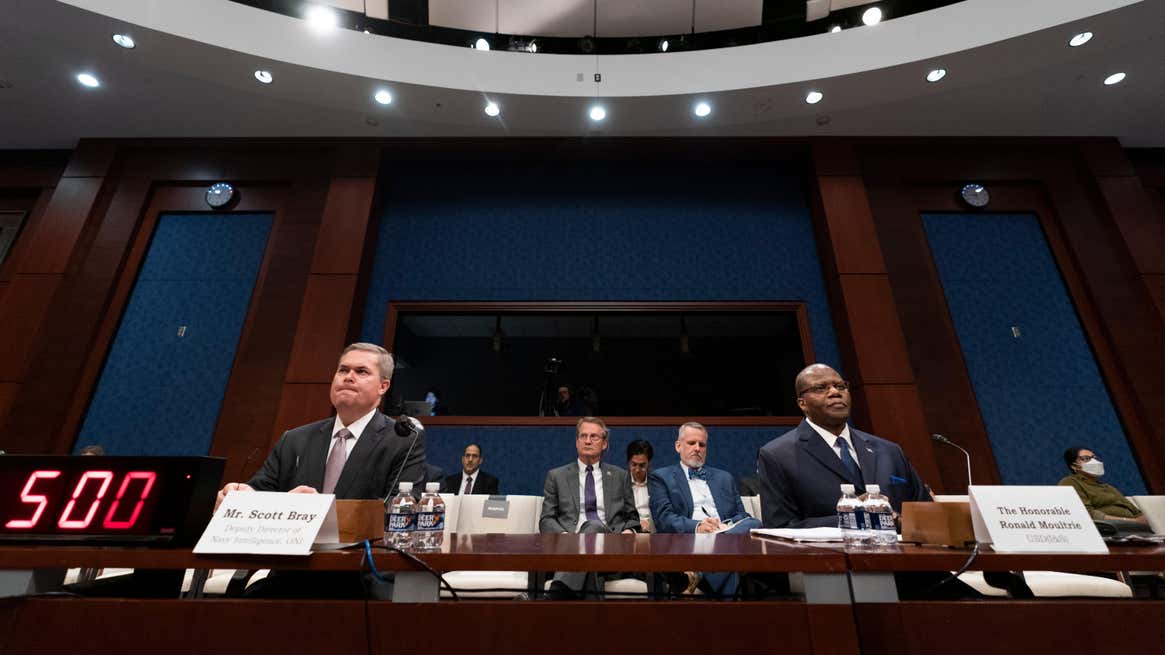The government has vowed to bring the conversation around odd aircraft to light after several videos captured by Navy pilots leaked online.
 |
| Photo: Alex Brandon (AP) |
Since the release of a Pentagon report on unidentified aerial phenomenon (UAP) last year, the number of reports by Navy pilots of mysterious, odd aircraft sightings has grown to approximately 400, top Pentagon officials revealed at the first public hearing on UAP held in nearly 50 years.
The hearing was held on Tuesday, and the two officials testified before a House subcommittee regarding the work that is currently being done to investigate U.S. military sightings of unidentifiable flying objects. UAPs are more commonly referred to as UFOs, and typically involve a flying object that maneuvers in ways that seemingly defy the laws of physics. As a result, sightings of these aircraft have largely been categorized as alien conspiracy or science-fiction. However, the government has vowed to bring the conversation around UAPs to light after several videos captured by Navy pilots leaked online.
“Our goal is to eliminate the stigma by bringing our operators and mission personnel into a standardized data gathering process,” Under Secretary of Defense for Intelligence and Security Ronald Moultrie said during the hearing, which was broadcast live on the committee’s YouTube Channel. “We believe that making UAP reporting a mission imperative will be instrumental to the effort’s success.”
The Department of Defense established an office dedicated to overseeing the collection and processing of UAP sightings’ reports. The chairman of the House Intelligence Subcommittee on Counterintelligence, Counterterrorism, and Counterproliferation (the subcommittee hosting the hearing) Andre Carson said that pilots have often avoided reporting these incidents, or were laughed at when they did. “Today, we know better,” Carson said during the hearing. “UAPs are unexplained, it’s true, but they are real. They need to be investigated and the many threats they pose need to be mitigated.”
The Pentagon report on UAPs was released in June 2021 as a result of the Intelligence Authorization Act, which called for the release of an unclassified, all-sources report on UAPs following leaked videos captured by U.S. Navy pilots. The videos first began circulating online before the U.S. Department of Defense officially released three unclassified videos on their website in April 2020.
The report was prepared by the Office of the Director of National Intelligence (ODNI) and the Pentagon’s UAP Task Force, and listed a total of 144 incidents that took place between the years 2004 to 2021. UAPs could fall into one of five categories, according to the report. The categories are airborne clutter (balloons, birds and other flying things of the sort), natural atmospheric phenomenon, U.S. industry developmental programs, foreign adversary systems (with China and Russia listed as potential sources), and finally an “other” category for unexplained phenomenon. Out of the 144, only one incident was identified as airborne clutter (it was a “large, deflating balloon”) while the remaining 143 sightings were left unexplained.
Although most of the report was inconclusive, it seemingly encouraged more pilots and military personnel to come forward with their own reports of UAP sightings. “Since the release of that preliminary report, the UAP Task Force database has now grown to contain approximately 400 reports,” Deputy Director of Naval Intelligence Scott Bray said during the hearing. “The stigma has been reduced.”
The task force was also able to resolve one of those incidents which involved a video of triangular objects floating off the West Coast as seen through night vision goggles. Bray told the subcommittee that these objects were actually unmanned aerial systems that only appeared to have a triangle shape due to light passing through the night vision goggles before the video was recorded by an SLR camera.
On the other hand, Bray showed the subcommittee another video of a spherical shaped object that quickly whizzes by the cockpit of an aircraft (so fast that Bray had to rewind and pause the footage several times for members of the hearing to see). “I do not have an explanation for what this specific object is,” he said.
Bray blamed “limited amount of high quality data and reporting,” for hampering their ability to identify these objects. But he’s hoping this will change as the UAP Task Force receives more reports, and as they call on a group of experts on physics, optics, meteorology, and other fields to help categorize the UAPs. The task force does not receive reports filed by civilians though.
“Our main objective was to transition UAP efforts from an anecdotal or narrative based approach to a rigorous science and technology engineering focused study,” Bray said at the hearing. “The message is now clear, if you see something you need to report it.”
Tags:
News
